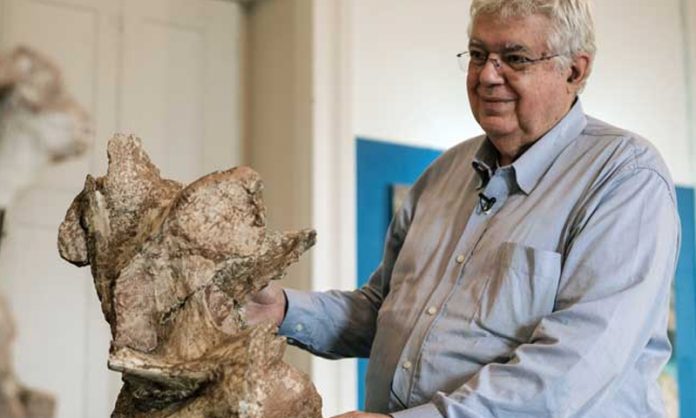RIO DE JANEIRO: Brazil just found it’s biggest ever dinosaur — in a storage cupboard. In its prime, more than 66 million years ago, this long necked herbivore was 25 meters (82 feet) long — longer than an articulated bus — and could chomp through trees at a terrifying rate.
By the time the creature was found by renowned Brazilian paleontologist Llewellyn Ivor Price in 1953, only a few hefty, fossilized bits of the spine remained.
Researchers knew immediately they’d stumbled on something big.
They didn’t have the staff or resources to figure out how big, however, so the dinosaur pieces languished the next six decades in storage at Rio’s ornate Museum of Earth Sciences.
Until now
The remains of what has been named “Austroposeidon magnificus,” and pronounced Brazil’s biggest dinosaur, went on general public view for the first time Thursday.
A nearly complete spinal vertebra — about the size of a microwave oven and entirely petrified — and numerous fragments of other vertebrae lie on a black cloth in an upper room of the museum.
Nearby hangs an enormous artist’s rendition, done to scale, of what “Austroposeidon magnificus” might have looked like: a small head, long neck, enormous body and long tail. A patch of the reptile’s skin is shown pulled back to reveal where the prize vertebra would have slotted in.
– ‘What, 60 years?’ –
Museum director Diogenes de Almeida Campos said six decades does sound on the slow side for studying such a big find.
“A friend said to me just yesterday, ‘Diogones, what, it took you 60 years?’,” he recalled with a wry smile. “It sounds a bit ridiculous to say this.”
But he explained that in the 1950s Price and his assistants were pioneers in the field for Brazil, and while “it was certain that vertebrae of this size came from a gigantic animal, it needed to be studied.”
Campos said money was an issue holding back research, as well as a lack of people up to the task. Even today there are only 10 serious dinosaur experts in the country, he said.
“We were waiting for the staff…, for a laboratory that started from nothing to mature,” he said. “We made a first effort with students about eight years ago and it didn’t succeed.”
Finally, Campos’ student Kamila Bandeira made the mysterious monster the subject of her doctoral thesis and over the last four years put the pieces of the puzzle together.





